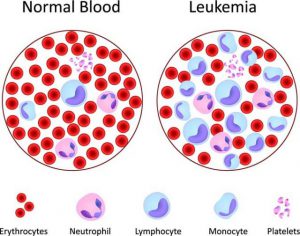Leukemia is a type of cancer that affects the blood and bone marrow.
Leukemia begins in a cell in the bone marrow. The cell undergoes a change and becomes a type of leukemia cell. Once the marrow cell undergoes a leukemic change, the leukemia cells may grow and survive better than normal cells. Over time, the leukemia cells crowd out or suppress the development of normal cells.
Patients who were single or divorced, patients who were uninsured or were Medicaid beneficiaries, and patients who lived in areas with lower income had substantially elevated risks of dying prematurely.
Dealing with physical changes that can result from the treatment. Worries about the leukemia returning or new health problems developing. Feelings of resentment for having had leukemia or having to go through treatment when others do not.Concerns about being treated differently or discriminated against (by friends, classmates, coworkers, employers, etc.).Concerns about dating, marrying, and having a family later in life. These are some things that affect your social life because of Leukemia.
No one chooses to have leukemia, but for many childhood leukemia survivors, the experience can eventually be positive, helping to establish strong self-values. Other survivors may have a harder time recovering, adjusting to life after cancer, and moving on.
It’s normal to have some anxiety or other emotional reactions after treatment, but feeling overly worried, depressed, or angry can affect many aspects of a young person’s growth.
It can get in the way of relationships, school, work, and other aspects of life. With support from family, friends, other survivors, mental health professionals, and others, many people who have survived leukemia can thrive in spite of the challenges they’ve had to face.
Chemotherapy is the main treatment for many types of leukemia. To cure leukemia, the main data needed for the doctors is: –
Type of Leukemia
The age of the patient
Chromosomal and Genetic Abnormalities
The overall health of the patient
Stem Cell Transplant may be an option for some people younger than 55 years of age.
Radiation therapy is most often used to prevent leukemia from spreading to, or treat leukemia that has spread to, the central nervous system (CNS). It is also used to prepare the bone marrow for stem cell transplant.
Targeted Therapy is offered for some types of leukemia.
Watchful waiting is a treatment option for some people with chronic lymphocytic leukemia (CLL).
Supportive therapy is given to manage the expected complications of the leukemia and its treatments.
Leukemia starts in the soft tissue between the bone, in the bone marrow and then spreads to the Circulatory System and then to the Nervous system more specifically, the Central Nervous System (CNS).
The most common method of transplant to cure leukemia is the Stem Cell Transplant (SCT) and the Bone Marrow Transplant (BMT).
The main ethical concern of an organ transplant is that
the use of living donors as volunteers including minors. It has also led to the practice of organ sale by entrepreneurs for financial gains in some parts the world through exploitation of the poor, for the benefit of the wealthy.
The main social misconception that needs to be corrected is the perception that the body of the donor would be mutilated and treated badly. This is not so, as the organs would be removed surgically through routine operations.
Cultural view about transplantation is varied. Some cultures give great importance to ancestral traditions and beliefs. They believe there is a transfer of the spirit from the donor to receipt and do special rituals for this process. That is why cultural extremists prohibit organ transplant which can be the best method to diagnose and cure Leukemia.